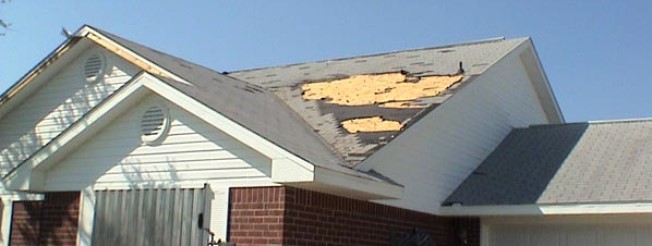
top 5 things to expect when filing a roof insurance claim.
your roof was damaged by a storm.
Here’s what to expect.
When filing a claim, most of our clients feel some hesitation at first.
For many, it’s their first time going through the insurance claims process. Since we work on insurance claims every day, our goal with this article is to explain what to expect from an insurance claim so you feel confident and prepared if you do need to file one.
1. Your premiums or rates will not go up because of a storm claim.
There are two kinds of claims: Natural Disaster/Acts of God Claims and Negligence Claims.
You cannot prevent storms from happening, and as such insurance companies are prohibited from penalizing homeowners and increasing your rates due to filing a claim for a natural disaster, including hailstorms, hurricanes, tornadoes, and thunderstorms.
If your home was damaged by an electrical or grease fire, flooding from an overflowing toilet, or you accidentally drove into the garage door, these claims would normally be covered by insurance, but since each of these could have been prevented, you may be penalized by your insurance carrier.
Your insurance rates will however increase the next billing year however, as insurance carriers do base your premiums on how many claims are filed in your zip code.
For more information, please read our in-depth Insurance Rates and Claims section.
2. Insurance claims can take a long time.
After a storm, hundreds of homeowners may file claims for damages to their homes. Insurance carriers do their best to handle each claim as quickly as possible, but the entire process still may take weeks.
The example below details the stages of a roof claim and how long each may take:
- You call your insurance carrier to file a claim – 15-20 minutes.
- The adjuster reaches out and schedules the adjustment – 3-10 business days.
- The adjuster inspects the home – 1-2 hours.
- The adjuster compiles and sends in their report – up to 48 hours.
- The claim manager reviews and approves/denies the claim – 7-10 Business Days.
- They send you a payment – Up to 7 days.
- **If the mortgage company needs to endorse the check this may add 1-2 weeks.
- You deposit the check and wait for funds to become available – 1-3 days.
- We collect a deposit and schedule the roof for replacement – 1-2 weeks.
- Total time before roof work can begin – 2-4 weeks.
- Depreciation released after work is complete – 1-2 weeks.
- Total time before work is completed and insurance pays out in full – 4-8 weeks.
A few other scenarios may further delay the claim, like if your mortgage has hoops to jump through to endorse the check, or if the claim is denied or only partially approved and we must supplement it to full replacement.
what we do to shorten the process
One thing we take pride in at Yellow Sun Contracting is our communication. We promise to continually follow up with the insurance carriers at every step of the process.
During our initial inspection, we act as if every claim is going to get denied and prepare a thorough report, order satellite measurements, weather data, and generate estimates so should the adjusters or claim managers need anything, we have it ready to go.
Whenever we make progress with the claim, we make sure to let you know, and all communication to the insurance company will also have you included so you’re always aware of what’s going on.
3. The insurance estimate is just that, an estimate.
If a claim is approved, the carrier will build an estimate based on how large and complex the roof is, the labor required, disposal, and their estimation of material prices.
Once you receive the estimate, which may be difficult to make sense of if you’ve never gone through an insurance claim before, we will review it together to make sure they properly paid for the roof replacement.
Most insurance companies use an industry-regulated estimating software called Xactimate. This software contains line items that have built-in pricing so that the insurance adjusters can easily write estimates to repair damages to your home.
Our estimators at Yellow Sun Contracting also use Xactimate to produce our estimates. This means that the only difference between the insurance carrier’s estimate and ours is the number of line items and the quantity of each.
For example, if the insurance carrier says your roof will require 2000 square feet of shingles to replace the roof but it actually requires 2400 square feet, or if they did not include items that are needed to bring the roof to pre-storm condition and up to current building codes, we can adjust or add line items and send our estimate for correction.
This process is called supplementing and is sometimes a necessary step as many insurance adjusters come in from out of town and do not know the local building codes. We do.
4. Your insurance carrier may split the payout into multiple payments.
When you receive your estimate from the insurance carrier, they will have the estimate separated into 3 separate amounts: The RCV (Replacement Cost Value), the Depreciation, and the ACV (Actual Cash Value).
The RCV is how much the insurance carrier is estimating that the total project will cost. Let’s use an example of an RCV of $10,000.
Depending on the age of your roof and what kind of policy you have, the insurance carrier may choose to withhold up to 50% of the total project cost until the work is completed. They withhold depreciation in order to protect themselves just in case you choose not to get the work done. If you do not complete the work, they don’t have to send the second check for the depreciated part of the claim. Let’s say they withhold $4,000.
The ACV then is the remainder after they deduct the depreciation from the RCV. In this case, $6,000. This is the depreciated value of your roof.
Then they deduct your deductible, let’s say $1,000, and your net ACV is $5,000.
Your first payment from the insurance carrier will be $5,000, even though the roof is approved for $10,000.
At Yellow Sun Contracting, we ask for the ACV and your deductible as a down payment to begin work. Once the roof is completed, we submit the Certificate of Completion (CoC) and photos of the completed work to the insurance carrier and wait for them to release the funds to you. In this example, we would be doing the full $10,000 worth of work for the $6000 down and waiting for the $4,000 Depreciation check to arrive to make us whole.
A few notes
Most homeowner insurance policies are written to include RCV coverage, however, there are a few insurance carriers that do write ACV-only policies. If you have an ACV-only Policy, you will only get the depreciated value of your roof, and you may have to come out of pocket for the remaining amount.
Also, if the insurance carrier’s estimate is written incorrectly or missing required line items, we may choose to hold off on re-roofing your home until the insurance carrier corrects their estimate. This may delay the process by a few days to a few weeks, but it is worth it in order to ensure proper repairs are done.
5. There’s a chance your roof damage insurance claim will be denied.
One thing to keep in mind when filing an insurance claim is that there’s a possibility that it could be denied or only partially approved. Even if we found what we consider severe and non-repairable storm damage on your roof, the insurance carrier still has the power to say no.
However, if they deny your claim because they do not agree that your roof has enough damage, there are ways to get the claim double and even triple-checked. You can even request to have a second adjuster inspect your roof.
Many carriers hire third-party roof inspectors called Ladder Assists and occasionally these inspectors do not, or cannot, approve full replacements. There are many guidelines they have to follow, and sometimes they simply cannot fully approve a roof even when it deserves it. If the carrier decides to send a second adjuster out, they are usually in a supervisor role and as such have more authority to push for a full replacement.
At Yellow Sun Contracting, we have a long history of flipping denials and partial approvals to full replacements. Whether it’s by speaking to the claim managers directly to make our case, submitting our reports of damages, submitting attempts to repair, or even meeting with a second adjuster or engineering firm, we have an excellent track record of success.
